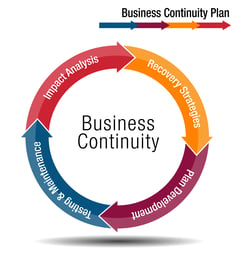Business Continuity: crisis management, natural disasters, asset protection, emergency management
While there have been many worse years for business throughout our history 2020 is arguably the worst many of us have seen in our lifetime. Many of us remember the collapse of the housing market in the U.S. in 2006 but most of us did not witness first had the Great Depression which covered most of the 1930’s. Few if any of us were directly impacted by the Opec Oil crisis of 1973 but the financial crisis of 2007 still stays fresh in our minds and the impact it had on business was detrimental. Today the world is smaller thanks to the ease of travel and Technology, but with our global economy expanding it brings new possibilities for disruption in businesses that we may not have anticipated in the past.
The U.S. government stepped in as expected to close the loopholes that caused many of these occurrences and bailed out numerous business, but this is not always the case and many business went under. Here is when we realize just how important a business continuity plan to our ongoing success. While the worlds focus remains on the coronavirus pandemic the presence of natural disasters and civil unrest has not abated. The coronavirus, with no end in site, will now have to be factored into business continuity plans thus making the already difficult task of crisis management even more difficult. Even without the worldwide pandemic 2020 was a year marked with natural disasters such as the Australian bush fires as well as the U.S. wild fire season going hand in hand with the various hurricanes that made landfall worldwide. Couple that with U.S. tensions with Iran, historic U.S. job losses, oil prices going negative for the first time in History and protests happening throughout the United States, the need to keep your business alive and profitable is increasingly more difficult.
So what exactly is business continuity? Well, business continuity is the planning and preparation that businesses take to ensure they have the capability to operate their key functions in the event of: Natural Disasters, work place violence, disruptions in the supply chain, pandemic, terrorism or any other factor that would result in a disruption.
Despite the difficulties businesses have to endure a positive attitude and planning are the keys to success. It is said that without positivity and planning productivity and continuity are a difficult task. During planning businesses should always make plans for as many scenarios as they can think of, truth is that if the plans are limited to just the ones they can think of they may be at a serious disadvantage. It is very unlikely that the majority of businesses planned for a worldwide pandemic coupled with lockdowns and quarantine mandates. Meanwhile riots and civil unrest occurred in many parts of the United States causing a further disruption in many peoples livelihoods. If 2020 accomplished anything it was a spectacular test of our business continuity plans and cause to rewrite them. Even some of the most savvy industry leaders failed to foresee
some the ancillary impacts of the pandemic. Products produced in foreign countries became hard to find, even additives needed for products produced in the United States were unavailable. How did these shortages affect business? What measures will be implemented so that work is not halted as we go forward? These are just a few questions we need to ask ourselves as we develop a plan to keep moving forward.
Business continuity plans are developed to keep the business safe in a plethora of circumstances that have a negative effect on operations. While the factors that effects a business varies greatly from business to business the importance of having a firm plan in place to continue operations and recover as quickly as possible is imperative.
In order for a business continuity plan to be effective it must follow defined stages:
Step 1
Step one begins with identifying what could go wrong within your business and defining the threats have to do with understanding the factors that could be disastrous to the business. Identify key items needed for operations to run efficiently. These items range from power to personnel and everything in between. After all if your in the business of selling lumber and you cannot get your product to market how long can you operate? If there is a natural disaster and your office space is inaccessible how do you continue to operate? How do you protect your assets if your business is located in a protest area? 2020 has taught us that when identifying possible disruptions to business operations it is best to think outside the box.
Disaster
A natural or man-made event or incident that significantly disrupts the environment of care, possibly resulting in damage to the building(s) and grounds due to severe natural events. A disaster is also an event that disrupts logistics, care and treatment, such as loss of utilities (power, water, telephone, etc.) due to natural or man-made events within the institution or in the surrounding community.

Emergency
A natural or man-made event that suddenly or significantly:
- Disrupts Business operations
- Disrupts clients ability conduct Business operations.
- Changes or increases demand for organizational services
An oral or written plan, commonly known as an Incident Action Plan (IAP) reflects the overall strategy for managing an incident within a prescribed timeframe (or operational period). An IAP includes the identification of operational resources and assignments and may include attachments that provide additional direction. At the simplest level, all IAP’s must have four elements:
) What we want to do and how are we going to do it?
2) Who is responsible for doing it?
3) How do we communicate with each other?
4) What is the procedure if incident personnel are injured or something goes wrong?
When identifying your companies risks some important scenarios that are a must to consider:
Natural Disasters
Most if not all companies will plan for natural disasters also known as acts of God. These occurrences are beyond our control and the impact on businesses is not ascertainable until after the
event. So how exactly does a Natural disaster effect business? And what are some natural disasters that you may want to consider when developing a business continuity plan?
Hurricane
A hurricane is a large rotating storm with high speed winds that forms over warm waters in tropical areas. Hurricanes have sustained winds of at least 74 miles per hour and an area of low air pressure in the center called the eye.
Landslide
Mass wasting that may include a large array of events ranging from rockfalls or land movement.
Flooding
An overflow of water that submerges dry land. There are numerous causes of flooding.
Earthquake
Earthquakes are usually caused when rock underground suddenly breaks along a fault. This sudden release of energy causes the seismic waves that make the ground shake.
Tornado
A tornado is a violently rotating column of air that is in contact with both the surface of the Earth and a cumulonimbus cloud or, in rare cases, the base of a cumulus cloud.
In the wake of any natural disaster, be it a hurricane, tornado, landslide or earthquake one can turn on the television and see firsthand the damage to property, but it is not the only impact a natural disaster causes. Economic activity is greatly hampered immediately after such a disaster. In many instances production is stopped, services are cancelled and as a whole products are not purchased. Natural disasters hamper our ability to move product as often times our mobility during these occurrences is greatly restricted. Natural disasters can also damage machinery, impact the local work force and put a halt to the national supply chain. The impact a natural disaster has on business depends in a large part where the occurrence takes place. In densely populated areas the impacts
are much greater than areas that are more sparsely inhabited. What this means is that while your operations may not be directly impacted by a natural disaster if it is located in a rural setting your customer base and labor force may be greatly impacted if the disaster occurs in a more urban setting.
Looking back at 2018, which was the fourth costliest year for natural disasters we can see just what an impact they have on the economy. according to Munich Re. They cost $160 billion, of which only half was insured. The worst damage came from U.S. Hurricanes Michael and Florence and Asian Typhoons Jebi, Mangkhut, and Trami. They cost $57 billion, of which $29 billion was insured. California wildfires cost $24 billion with insured losses of $18 billion. There were 29 events that cost at least $1 billion each. In June 2019, Congress passed a $19.1 billion disaster aid package. (The White House, 2019)
When looking at the uninsured losses we can see why it is so important to keep an up to date business continuity plan to protect your assets as well as maintain operations.
Civil Unrest
The immediate impacts of civil unrest and rioting are felt immediately by businesses. Damaged property, loss of goods and the suspension of services are only but a few of the impacts. The long-term effects of such events are carried over for decades. After a large-scale period of unrest where there is property damage and theft businesses that are in those areas suffer long term hardships often unforeseen. William Collins and Robert Margo, economists who studied the effect of the riots that followed the assassination of Martin Luther King, Jr., in 1968, found that in areas most affected by the destruction, property values were measurably depressed in the years immediately following the riots and remained so into the 1980s, at least. As you can imagine declining property value and loss of equity can have a detrimental effect on companies, especially those that own property and buildings.
Insurance companies are expected to pay out over 25 million dollars in Minnesota alone due to recent events. The result will most likely be higher insurance premiums down the road.
It is very difficult to determine the actual impact civil unrest, or more accurately rioting, has on the economy in the long term. The most costly example of civil disorder dates back to 1992 and the rioting associated with the beating of Rodney King. While insurers know that at the time they paid out $775 million the long term effects are still being studied.
Pandemic
Unlike an epidemic that is a disease that affects a large number of people within a region a pandemic is spread over multiple countries or even continents. In essence anything with an infection rate of 15 cases per 100,000 people for two consecutive weeks over multiple countries is a pandemic. While in 2009 the swine flu pandemic was the last pandemic we encountered the impact to business was minimal if at all, and the death rates paled in comparison to todays Covid-19 numbers. Excluding the HIV/AIDS pandemic the world has not been so impacted by a pandemic since 1918 Influenza (Spanish flu) outbreak.
During a pandemic much like the one we are experiencing now businesses have to prepare for premature deaths of key stakeholders, employee absenteeism and a general overall lack of productivity. Additionally, how will global supply chain disruptions and production closures affect you?
In the United States, the proportion of people out of work hit a yearly total of 8.9%, according to the International Monetary Fund (IMF), signaling an end to a decade of jobs expansion.
Millions of workers have also been put on government-supported job retention schemes as parts of the economy, such as tourism and hospitality, have come to a near standstill. The numbers of new job opportunities is still very low in many countries and in the United States our unemployment rates have seen record numbers.
While these are just some examples it’s a start to helping to identify what can go wrong in business operations by no means is this an exhausted list. Every business is different and is impacted differently from events that take place outside of their realm of control.
Cyber Security
While trying to anticipate every potential impact on a business we cannot forget the protection of our information and our operating systems. No matter the size of your business technology has both an tangible and intangible impact on your operations. Technology impacts everything from information storage and organization to communication and efficiency. It is important to understand in what methods can be used to compromise the integrity of your platform. IT vulnerabilities range from compromised passwords to Malware that can accomplish a plethora of malicious activity and wreak havoc on an operating system.
The importance of preparation and the IT professional’s role in protecting technology is undeniable.
Step 2
Once you have identified the possible disruptions in service it is time to develop plans to mitigate those disruptions. If your business is closed for any reason do you have a plan? Can you quickly and efficiently reroute operations to another office? Do you have generators in case of extended power outages? Is there a platform in place so that in case of mass lockdowns employees can work remotely? During Step 2 it is important to consider worst case scenarios and what is needed to keep operations up and running. Some critical functions to consider once you’ve identified potential risks are:
- Employee support- How are you going to support your staff during a time of crisis
- Essential Personnel- Have you identified essential personnel and teams to effectively manage the crisis?
- Process- Who or what is essential in completing their tasks
- Communication- How will you disseminate information to your vendors, employees and customers.
- Supply Chain- Can you deliver your product or service?
- Timeline- the order and time frame needed to get your business operational
- Staffing- Do you have the capability to adequately staff during and post interruption in business.
- Government mandated shutdowns.
- Documentation- This is a clear and concise step by step plan to get your business up and running as quickly as possible.
- Asset Protection-Loss of assets could be devastating and while insurance may cover some of the losses it cannot be the whole of your plan
- Emergency Management- goes hand in hand with business continuity in managing the effects of emergency situations.
Keep in mind that while your particular business may deem some of these items as key functions you may have many more that are not listed here.
Step 3
The safety control measures should ensure a direct mitigation of the effects of the disaster so that the activities of the business or it’s assets or personnel will not suffer substantial damage or be irretrievably lost. The next stage is to conduct a test run. A test run involves running a simulation to ensure that the system in place is effective. A businessman should ensure that this safety measures indeed serves its purpose. The next step which should be a continuous process should be a continuous review of the safety control measures. The reason for this procedure is to ensure that the measures in place are up to date. So depending on the situation being handled the business owner is to run simulations at quite regular intervals to ensure that what is supposed to be safe isin fact safe. For tech companies where upgrades are made on a quite regular interval, a timely review is to be made to ensure that the safety control measures covers the most recent updates in technology that could also be a threat.
While we have identified some aspects that may disrupt business and a simple step process to assist you in developing a plan for business continuity in times of crisis by no means is this an exhaustive list of possibilities. When developing your plan you have to know your business and the forces both inside and out that may affect your operations. Business vary in their functions and services and some of the topics we have discussed may be deemed unimportant while others may have catastrophic impacts on your operations. It is imperative that you develop a plan that works best for you and your business to operate no matter what the disruption may be.
While no one can predict the next disaster, terrorist attack or pandemic we as security professionals have a moral and ethic obligation to ensure our corporations are prepared in order to best preserve life, limit loss and minimize property damage.
By Doug Ruhl, VP of Business Development
Strategic Security Corp.
Tags: #emergencyresponse, #emergency, #services




